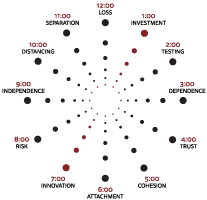At the beginning, teammates invest (winter) in a future together and carefully define its direction. As the team becomes close and discovers how to work out differences, trust (spring) becomes the fuel for connection. The foundation of shared goals becomes a platform for innovation (summer). This exploration creates change, which requires some distancing (autumn) to adjust to what’s been lost and adapt to the new circumstances.

The Team Clock® model was conceived in 1980 as an alternative to the 1965 Tuckman Forming-Storming-Norming-Performing theory. Rather than viewing a team as a time-limited task group with a beginning, middle and end, the Team Clock® model views teams as ever-evolving, living entities that cycle through stages of investment, trust, innovation and distancing, only to re-invest and repeat the cycle.
Imagine 12 hours of a clock, where each hour represents a phase (month) of a team’s development. The nature of teams is that you are ALWAYS planning for ALL hours/months of the season, regardless of what season you’re in.

The 12 Questions Method prompts consideration for all twelve months through the lens of the season your team is currently experiencing. The questions change during each season because the seasons change. After all, how we think about August is different when we’re in February than when we’re in July. The result is an evolving set of 12 questions.
Let’s begin in the ‘winter’ of a team’s development and move through each season. The ‘in-season’ questions are in bold.
Winter (Investment/Foundation)
Here are questions for every month from Winter’s perspective.
1:00 (January): What are our team norms, rules, roles, responsibilities and goals?
2:00 (February): How can our differences and conflicts be leveraged as strengths?
3:00 (March): What is our common vision?
4:00 (April): Is everyone committed and accountable to our deliverable?
5:00 (May): How do we harness our network to maximize collaboration?
6:00 (June): Do we have a sufficient foundation of connection to support experimentation?
7:00 (July): How do we find new ways to solve future problems?
8:00 (August): Can we endure the discomfort of risk-taking to create something new?
9:00 (September): How do we manage the change we’ve created to support our vision?
10:00 (October): Can we step back and get perspective on our new circumstances?
11:00 (November): How do we best refuel and refocus now that things have changed?
12:00 (December): What has evolved and where are we headed in our team/project landscape?
Spring (Trust/Connection)
Here are questions for every month from Spring’s perspective.
1:00 (January): Do we need to revise, re-anchor or recommit to foundation roles, goals, etc.?
2:00 (February): Are there new conflicts or unexpected challenges that need attention?
3:00 (March): Has our vision and/or goals shifted?
4:00 (April): Where are the strongest and weakest connections within the team?
5:00 (May): Is there talent in our external networks who should be invited to the team?
6:00 (June): Is team trust reliable and dependable as we venture into our next phase of growth?
7:00 (July): What are the avenues no one has considered yet?
8:00 (August): Are we prepared for the consequences being daring, controversial or unsafe?
9:00 (September): Have we altered the vision with our creative efforts?
10:00 (October): What have we learned when we widen the lens and look at the big picture?
11:00 (November): What different people and resources are needed for the next phase?
12:00 (December): Can we take a moment to exhale and regroup?
Summer (Innovation/Creation)
Here are questions for every month from Summer’s perspective.
1:00 (January): How do our roles overlap and when are we allowed in each other’s lanes?
2:00 (February): Are there any relationship issues on the team that need attention?
3:00 (March): Have we been ambitious enough with our goals?
4:00 (April): Have we normalized and trust breaches?
5:00 (May): Which teammates have formed natural chemistry and partnership?
6:00 (June): Is there sufficient psychological safety to support disruptive innovation?
7:00 (July): What creativity tools and exercises would promote greater exploration and discovery?
8:00 (August): Have we factored in the costs and benefits of failure?
9:00 (September): Are we prepared to deliver our creation to the market?
10:00 (October): What are the lessons learned from this project?
11:00 (November): Are we ready to walk away and devote our time and talent elsewhere?
12:00 (December): What aspects of our collaboration can be delivered to the next iteration of this team?
Autumn (Distancing/Renewal)
Here are questions for every month from Autumn’s perspective.
1:00 (January): In what ways does the infrastructure of this team lend to future creative endeavors?
2:00 (February): Is everyone onboard for the rigors of the next level of collaboration?
3:00 (March): In an ideal world, what is the next target of change?
4:00 (April): How has our network of connections been strengthened for future work together?
5:00 (May): With whom would each teammate like most (and least) to partner in the next round?
6:00 (June): How do we best celebrate our accomplishments?
7:00 (July): How do we avoid complacency and stay energized?
8:00 (August): What would be the most daring innovation to undertake?
9:00 (September): Has the team embraced the reality of continuous change?
10:00 (October): What are the 20/20 hindsight epiphanies?
11:00 (November): What do we need to abandon as obsolete?
12:00 (December): Have we fully let go of all unresolved issues in preparation for a renewal?
All relationships travel through seasons of growth and change.
Whether it’s two people in a partnership, a team of people with a common goal or an organization with a mission, the living entity evolves through predictable stages. At each stage, there is an evolving set of 12 questions that will ensure your team’s success. Keep asking. Cycle after cycle, season after season.

